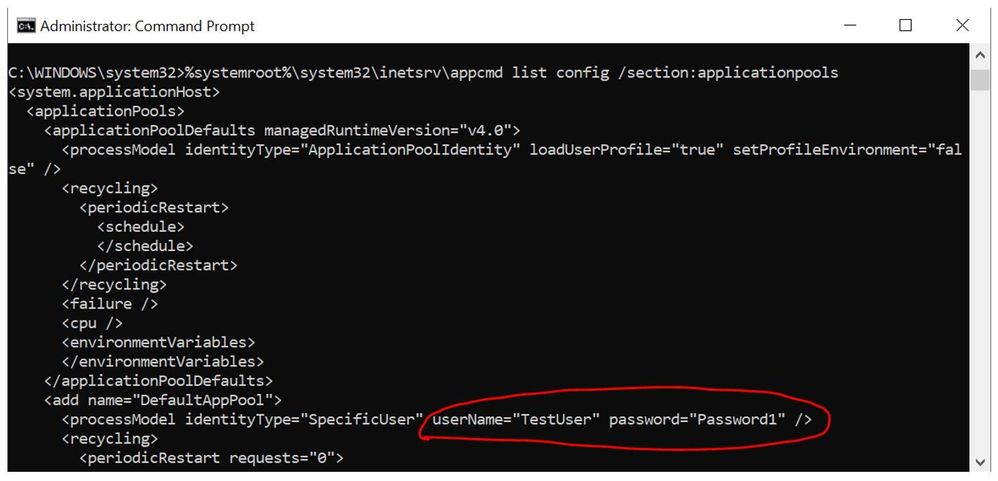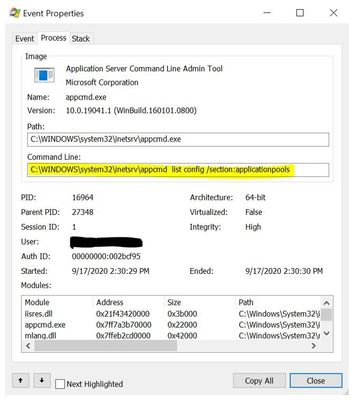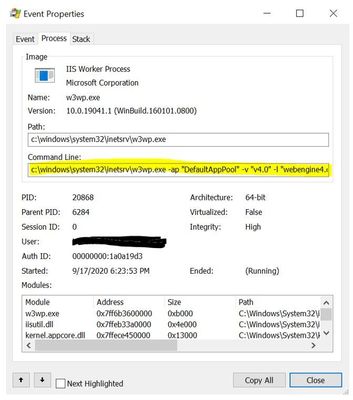
by Scott Muniz | Sep 18, 2020 | Uncategorized
This article is contributed. See the original author and article here.
In IIS Manager, the application pool identity set to a custom service account will always display it’s password in encrypted (masked) format. In applicationHost.config file also the password will show as encrypted.
But when you run the below command in a command line tool then the password is visible.
%systemroot%system32inetsrvappcmd list config /section:applicationpools
 Is there a way to encrypt the password in the command line?
Is there a way to encrypt the password in the command line?
The AppCmd tool uses the same interfaces to read the configuration data that the Windows Process Activation Service uses to read the same configuration data.
Sample dll stack: (Collected using Procmon)
| AppCmd tool |
Windows Process Activation Service |
|
0 ntoskrnl.exe SeOpenObjectAuditAlarmWithTransaction + 0x4ad8 0xfffff8064bed03c8 C:WINDOWSsystem32ntoskrnl.exe
1 ntoskrnl.exe SeOpenObjectAuditAlarmWithTransaction + 0x16ac 0xfffff8064beccf9c C:WINDOWSsystem32ntoskrnl.exe
2 ntoskrnl.exe SeOpenObjectAuditAlarmWithTransaction + 0x57ee 0xfffff8064bed10de C:WINDOWSsystem32ntoskrnl.exe
3 ntoskrnl.exe ObOpenObjectByNameEx + 0x1fa 0xfffff8064beda39a C:WINDOWSsystem32ntoskrnl.exe
4 ntoskrnl.exe ObOpenObjectByName + 0x5c 0xfffff8064beda17c C:WINDOWSsystem32ntoskrnl.exe
5 ntoskrnl.exe SeQueryInformationToken + 0xcf1 0xfffff8064bed9ca1 C:WINDOWSsystem32ntoskrnl.exe
6 ntoskrnl.exe NtFsControlFile + 0x582 0xfffff8064be4f2a2 C:WINDOWSsystem32ntoskrnl.exe
7 ntoskrnl.exe setjmpex + 0x7cc5 0xfffff8064bc058b5 C:WINDOWSsystem32ntoskrnl.exe
8 ntdll.dll ZwOpenKey + 0x14 0x7ffed2cac004 C:WindowsSystem32ntdll.dll
9 bcryptprimitives.dll ProcessPrng + 0x3b5c 0x7ffed08285ec C:WindowsSystem32bcryptprimitives.dll
10 bcryptprimitives.dll ProcessPrng + 0x39dd 0x7ffed082846d C:WindowsSystem32bcryptprimitives.dll
11 bcryptprimitives.dll ProcessPrng + 0x3934 0x7ffed08283c4 C:WindowsSystem32bcryptprimitives.dll
12 bcryptprimitives.dll GetKeyDerivationInterface + 0x13b3e 0x7ffed08474de C:WindowsSystem32bcryptprimitives.dll
13 ntdll.dll RtlActivateActivationContextUnsafeFast + 0x11d 0x7ffed2c47b3d C:WindowsSystem32ntdll.dll
14 ntdll.dll RtlGetThreadErrorMode + 0x313 0x7ffed2c73403 C:WindowsSystem32ntdll.dll
15 ntdll.dll RtlGetThreadErrorMode + 0xa6 0x7ffed2c73196 C:WindowsSystem32ntdll.dll
16 ntdll.dll TpAllocTimer + 0x1c3 0x7ffed2c50d13 C:WindowsSystem32ntdll.dll
17 ntdll.dll LdrGetDllHandleEx + 0x4f6 0x7ffed2c44ca6 C:WindowsSystem32ntdll.dll
18 ntdll.dll ApiSetQueryApiSetPresenceEx + 0x5a4 0x7ffed2c4c414 C:WindowsSystem32ntdll.dll
19 ntdll.dll RtlDosPathNameToRelativeNtPathName_U + 0xd2 0x7ffed2c4c612 C:WindowsSystem32ntdll.dll
20 ntdll.dll RtlVirtualUnwind + 0xae7 0x7ffed2c32b97 C:WindowsSystem32ntdll.dll
21 ntdll.dll LdrResolveDelayLoadedAPI + 0xc6 0x7ffed2c44196 C:WindowsSystem32ntdll.dll
22 rpcrt4.dll RpcErrorGetNextRecord + 0x242 0x7ffed2b04572 C:WindowsSystem32rpcrt4.dll
23 rpcrt4.dll I_RpcServerSetAddressChangeFn + 0xc71 0x7ffed2b11c81 C:WindowsSystem32rpcrt4.dll
24 rpcrt4.dll UuidCreate + 0x15 0x7ffed2af6945 C:WindowsSystem32rpcrt4.dll
25 combase.dll CoInitializeEx + 0x1688 0x7ffed2132588 C:WindowsSystem32combase.dll
26 combase.dll CoInitializeEx + 0xdf3 0x7ffed2131cf3 C:WindowsSystem32combase.dll
27 combase.dll CoInitializeEx + 0xd95 0x7ffed2131c95 C:WindowsSystem32combase.dll
28 combase.dll CoInitializeEx + 0x750 0x7ffed2131650 C:WindowsSystem32combase.dll
29 combase.dll RoGetActivatableClassRegistration + 0x45ca 0x7ffed213080a C:WindowsSystem32combase.dll
30 combase.dll CoInitializeEx + 0x268 0x7ffed2131168 C:WindowsSystem32combase.dll
31 combase.dll CoInitializeEx + 0x58 0x7ffed2130f58 C:WindowsSystem32combase.dll
32 appcmd.exe CLockBase<4,1,1,2,3,3>::LockType + 0x1898 0x7ff7a3b75758 C:WindowsSystem32inetsrvappcmd.exe
33 appcmd.exe STRAU::SafeCopy + 0x58d 0x7ff7a3b81f4d C:WindowsSystem32inetsrvappcmd.exe
34 kernel32.dll BaseThreadInitThunk + 0x14 0x7ffed14b6fd4 C:WindowsSystem32kernel32.dll
35 ntdll.dll RtlUserThreadStart + 0x21 0x7ffed2c5cec1 C:WindowsSystem32ntdll.dll

|
0 ntoskrnl.exe SeOpenObjectAuditAlarmWithTransaction + 0x4ad8 0xfffff8064bed03c8 C:WINDOWSsystem32ntoskrnl.exe
1 ntoskrnl.exe SeOpenObjectAuditAlarmWithTransaction + 0x16ac 0xfffff8064beccf9c C:WINDOWSsystem32ntoskrnl.exe
2 ntoskrnl.exe SeOpenObjectAuditAlarmWithTransaction + 0x57ee 0xfffff8064bed10de C:WINDOWSsystem32ntoskrnl.exe
3 ntoskrnl.exe ObOpenObjectByNameEx + 0x1fa 0xfffff8064beda39a C:WINDOWSsystem32ntoskrnl.exe
4 ntoskrnl.exe ObOpenObjectByName + 0x5c 0xfffff8064beda17c C:WINDOWSsystem32ntoskrnl.exe
5 ntoskrnl.exe SeQueryInformationToken + 0xcf1 0xfffff8064bed9ca1 C:WINDOWSsystem32ntoskrnl.exe
6 ntoskrnl.exe NtFsControlFile + 0x582 0xfffff8064be4f2a2 C:WINDOWSsystem32ntoskrnl.exe
7 ntoskrnl.exe setjmpex + 0x7cc5 0xfffff8064bc058b5 C:WINDOWSsystem32ntoskrnl.exe
8 ntdll.dll ZwOpenKey + 0x14 0x7ffed2cac004 C:WindowsSystem32ntdll.dll
9 bcryptprimitives.dll ProcessPrng + 0x3b5c 0x7ffed08285ec C:WindowsSystem32bcryptprimitives.dll
10 bcryptprimitives.dll ProcessPrng + 0x39dd 0x7ffed082846d C:WindowsSystem32bcryptprimitives.dll
11 bcryptprimitives.dll ProcessPrng + 0x3934 0x7ffed08283c4 C:WindowsSystem32bcryptprimitives.dll
12 bcryptprimitives.dll GetKeyDerivationInterface + 0x13b3e 0x7ffed08474de C:WindowsSystem32bcryptprimitives.dll
13 ntdll.dll RtlActivateActivationContextUnsafeFast + 0x11d 0x7ffed2c47b3d C:WindowsSystem32ntdll.dll
14 ntdll.dll RtlGetThreadErrorMode + 0x313 0x7ffed2c73403 C:WindowsSystem32ntdll.dll
15 ntdll.dll RtlGetThreadErrorMode + 0xa6 0x7ffed2c73196 C:WindowsSystem32ntdll.dll
16 ntdll.dll TpAllocTimer + 0x1c3 0x7ffed2c50d13 C:WindowsSystem32ntdll.dll
17 ntdll.dll LdrGetDllHandleEx + 0x4f6 0x7ffed2c44ca6 C:WindowsSystem32ntdll.dll
18 ntdll.dll ApiSetQueryApiSetPresenceEx + 0x5a4 0x7ffed2c4c414 C:WindowsSystem32ntdll.dll
19 ntdll.dll RtlDosPathNameToRelativeNtPathName_U + 0xd2 0x7ffed2c4c612 C:WindowsSystem32ntdll.dll
20 ntdll.dll RtlVirtualUnwind + 0xae7 0x7ffed2c32b97 C:WindowsSystem32ntdll.dll
21 ntdll.dll LdrResolveDelayLoadedAPI + 0xc6 0x7ffed2c44196 C:WindowsSystem32ntdll.dll
22 rpcrt4.dll RpcErrorGetNextRecord + 0x242 0x7ffed2b04572 C:WindowsSystem32rpcrt4.dll
23 rpcrt4.dll I_RpcServerSetAddressChangeFn + 0xc71 0x7ffed2b11c81 C:WindowsSystem32rpcrt4.dll
24 rpcrt4.dll UuidCreate + 0x15 0x7ffed2af6945 C:WindowsSystem32rpcrt4.dll
25 combase.dll CoInitializeEx + 0x1688 0x7ffed2132588 C:WindowsSystem32combase.dll
26 combase.dll CoInitializeEx + 0xdf3 0x7ffed2131cf3 C:WindowsSystem32combase.dll
27 combase.dll CoInitializeEx + 0xd95 0x7ffed2131c95 C:WindowsSystem32combase.dll
28 combase.dll CoInitializeEx + 0x750 0x7ffed2131650 C:WindowsSystem32combase.dll
29 combase.dll RoGetActivatableClassRegistration + 0x45ca 0x7ffed213080a C:WindowsSystem32combase.dll
30 combase.dll CoInitializeEx + 0x268 0x7ffed2131168 C:WindowsSystem32combase.dll
31 combase.dll CoInitializeEx + 0x58 0x7ffed2130f58 C:WindowsSystem32combase.dll
32 w3wp.exe w3wp.exe + 0x12dd 0x7ff6b36012dd C:WindowsSystem32inetsrvw3wp.exe
33 w3wp.exe w3wp.exe + 0x363d 0x7ff6b360363d C:WindowsSystem32inetsrvw3wp.exe
34 kernel32.dll BaseThreadInitThunk + 0x14 0x7ffed14b6fd4 C:WindowsSystem32kernel32.dll
35 ntdll.dll RtlUserThreadStart + 0x21 0x7ffed2c5cec1 C:WindowsSystem32ntdll.dll

|
At some point we have to decrypt the password to hand it off to LSA to log in the account and both WAS and AppCmd can do this, but it is dependent on running as either Local System or a local administrator.
If we run the same command using an account that is not a local administrator, it will fail.
 By design, it is architecturally infeasible to prevent an administrator from being able to read the password in this manner.
By design, it is architecturally infeasible to prevent an administrator from being able to read the password in this manner.
AppCmd is an IIS admin tool that requires admin privilege to run. Therefore, showing the password doesn’t break the security boundary. On the other hand, if the goal is to prevent “peeking over the shoulder” or “leaking password from the admin script logs”, it might be helpful to have a switch for the command line to mask the passwords. Unfortunately, such an option was never added.
by Scott Muniz | Sep 18, 2020 | Uncategorized
This article is contributed. See the original author and article here.
More and more life science organizations are looking to leverage cloud-based solutions that can be used anywhere, on any device, to support “good practice” quality guidelines and regulations (GxP). To carry out their digital transformation, customers in regulated industries trust Microsoft cloud services such as Microsoft 365, Azure, and Dynamics 365 to shorten their time to market, reduce costs, increase operational efficiency, and accelerate scientific innovation.
Each year Microsoft invests billions of dollars in designing, building, and operating innovative cloud services. But in this highly regulated industry, for you to even consider our services, we must earn and retain your trust. Microsoft cloud services are built around key tenets of security, privacy, transparency, and compliance; and we invest more each year to increase the confidence of our life sciences customers in Microsoft cloud services.
Microsoft aims to ensure the confidentiality, integrity, and availability of data, documents, and GxP applications for life science organizations. With each service, customer data benefits from multiple layers of security and governance technologies, operational practices, and compliance policies to enforce data privacy and integrity at specific levels.
Over time, we intend to make it easier for life sciences organizations to use Microsoft cloud services for their full portfolios of applications. We believe that this GxP guidance document is a key step toward that goal. Given the shared responsibilities of the cloud model, life science customers rely on the fact that Microsoft has implemented appropriate technical and procedural controls to manage and maintain the cloud environment in a state of control. Microsoft’s quality practices and secure development lifecycle encompass similar core elements as would be found in many life sciences customers’ internal Quality Management Systems and meet or exceed industry standards.
This guide should help demonstrate that you can develop and operate GxP applications on Microsoft Azure, Dynamics 365, and Microsoft 365 with confidence and without sacrificing compliance with GxP regulation. We look forward to working with you to help you achieve your digital transformation initiatives.
– Daniel Carchedi – Sr. Director Business Development & Strategy Life Sciences
GxP Guidelines for Microsoft 365, Dynamics, and Azure are attached below
Webinars to check out:
The future of digital collaboration in pharma and biotech: The Microsoft 365 Journey
Accelerate your journey to the cloud: Move your GxP regulated workloads to Microsoft Azure
Register for the GxP Cloud Compliance Summit October 20th and 21st
by Scott Muniz | Sep 18, 2020 | Azure, Technology, Uncategorized
This article is contributed. See the original author and article here.
Ignite 2020 is next week! Are you excited, because we are! Always great to hear announcements and product developments from the leadership teams, developers and engineers on what we’ve been working on and what’s to come.
Be sure to register! In the meantime here are the other upcoming events and recent posts from the advocate team.
Key Events
Create: Serverless – aka.ms/createserverless
In this 4 hour event, hear from our keynote speakers Chris Coyier and Chris Nwamba on the Serverless landscape in 2020 and the trends you should look out for.
You will also learn:
· How you can unify data with Hasura GraphQL Engine & Azure Functions by Allison Kunz and Burke Holland
· Serverless security 101 by Guy Podjarny and Wassim Chegham
· How to develop low-code Serverless Applications by Linda Nichols and Dona Sarkar
· Overcoming Serverless challenges with Durable Functions by Marc Duiker and Anthony Chu
· Boost your Serverless APIs with API Management by Mike Budzynski and Jeff Hollan
· Serverless Best Practices by Marie Hoeger and Robert Steele
.NET Conf 2020 (dotnetconf.net)
.NET Conf is a free, three day virtual developer event co-organized by the .NET community and Microsoft. This year .NET 5.0 will launch at .NET Conf 2020! Come celebrate and learn about the new release. We’re also celebrating our 10th anniversary and we’re working on a few more surprises. You won’t want to miss this one.
Content Wrap Up
Distributed Tracing With Jaeger and Linkerd
Lucas Santos
In this article, I explain how we can integrate your service mesh using linkerd with distributed tracing using Jaeger
Building Serverless APIs with Azure Functions and Azure SQL
In this article, We discuss about Serverless Computing, Azure Function and Azure SQL in a concise manner. Then. We discuss how to make one using Visual Studio 2019 using C#. In this article, We create an HTTP Trigger Azure Function to Insert a value into our Table in Azure SQL Database every time we make a request to it by passing a name in the query string or the request body. We’ll be using ADO.NET for the database interaction and see how easy it is to make a Serverless Application to perform Insert operations to our database.
Serverless Prediction of a Product Feedback [Community]
If you are developing any product, feedback is much more important. You must trace every feedback like feature request or Bugs/Issues. Open Source projects are much easier to track the feedbacks /bugs, however when coming to any non-open-source projects it is always difficult. In this post, Jayendran explains using the power of serverless how we can grab and maintain every feedback and issues easily in real-time.
Creating a Serverless Resume with Visitor Counter in Azure
What’s a better way to showcase your experience with Azure serverless if not by building your resume/portfolio website using azure serverless services?. I would teach you how to build a resume/portfolio website with a serverless service to store the visitor’s count (Azure Cosmos DB), a serverless service to retrieve and update the visitor’s count from our store(Azure Functions), a serverless service to host our static resume website (Azure Storage) and an additional service to cache and make our static website load faster (Azure CDN).
Crazy Web Performance with Azure Static Web Apps and Azure Functions
Azure Static Web Apps has been a game changer for me in terms of how I build and deploy static web applications. In this post, I talk about why I made the switch to Azure Static Web Apps and also answer some of the common questions I’ve received about the platform!
Serverless with GraphQL
Everything on Azure. Scalable and cost-effective Serverless system leveraging GraphQL API hosted on Azure. Easy deployable and production-ready code with Azure CLI and Azure DevOps. Built a simple API to query your professional details. You can modify and create your own API, isn’t it beautiful.
How to bridge Go AMQP library to Service Bus
Alvaro Videla Godoy
Blog/ What is Bicep? The ARM Template DSL
Justin Yoo
This post discusses how Bicep, the ARM template DSL, looks like and how we can leverage it for ARM template authoring.
How to manage existing Azure Resource Groups using Terraform
Anthony Bartolo
As many organizations look to adopt Infrastructure as Code and DevOps as the new norm, one question that repeatably gets asked is “We have already deployed resources into Azure, how can we manage them in IaC without having to recreate them?”. Say hello to Terraform Import!
Azure Stack Hub Partner Solutions Series – Knowledge Park
Thomas Maurer
Today, I want you to introduce you to Azure Stack Hub Partner Knowledge Park..
The Azure Stack Hub Partner Solutions Series journey continues with a few partners that create a SaaS-like experience for their customers. The knowledgepark, akquinet, and BordonaroIT are working together across different levels of the solution (form the top application, all the way to the platform fabric) to provide SaaS services for over 200 Healthcare environments across the region. See how they are working together to achieve this.
The Curious Developer’s Guide to Portable Azure Functions
Azure Functions allow you to execute small snippets of code, in the cloud, without concern for cloud infrastructure. These functions are triggered by several different types of event sources, making them the building blocks of an event-driven or “serverless” architecture. They’re easy to write, deploy, and connect to other cloud services to create powerful applications. Azure Functions are also open source! But did you know they’re also… portable?
Xamarin Podcast Ep 77: Surface Duo, Android Startup Times, and Xamarin.Essentials
Matt Soucoup
This month James and Matt talk about new Microsoft Learn modules on the Surface Duo. The continuing saga of the Xamarin.Forms Shell quick tips.
Join the Microsoft Azure Hybrid Cloud Webinar Series from Microsoft Indonesia
Thomas Maurer
Together with Microsoft Indonesia, we are offering an Azure Hybrid Cloud Webinar Series with two webinars around Azure Hybrid Cloud. The first one on September 22nd will be called: Innovation Anywhere with Azure Hybrid and on September 23rd: Deep Dive VM and Kubernetes Management to any Infrastructure with Azure Arc
Go Full-Stack for the First Time by Microsoft Technologies
There was a time when Microsoft hated opensource. In the last decade, they realized that opensource is the future and decided to start heavily investing in it. They went from zero to hero. Today, Microsoft has the most opensource contributors and they are the third most active opensource organization. A lot of key elements of the opensource world belong to Microsoft. They have reached the point where you can be a full-stack developer without leaving the Microsoft ecosystem, and I’ll tell you why it is a game-changer.
Top 10 Things to Look Out for When Using Microsoft Teams
Anthony Bartolo
Veronique looks Ten things that happen when performing something specific in Microsoft Teams.
Blog on Messaging Extension using Teams Toolkit
Rabia Williams
Create a get started blog post for new developer who wants to get started on developing Messaging extensions using the Teams Toolkit
Live Coding on Twitch: Developing Node.js + Angular + PostgreSQL Application – Day 09
Glaucia Lemos
Azure Migrate and Availability Zones
Sarah Lean
Explaining the new feature in Azure Migrate where you can migrate your VMs straight into Availability Zones or Sets.
Azure Stack Hub Partner Solutions Series – Knowledge Park
Thomas Maurer
Today, I want you to introduce you to Azure Stack Hub Partner Knowledge Park..
The Azure Stack Hub Partner Solutions Series journey continues with a few partners that create a SaaS-like experience for their customers. The knowledgepark, akquinet, and BordonaroIT are working together across different levels of the solution (form the top application, all the way to the platform fabric) to provide SaaS services for over 200 Healthcare environments across the region. See how they are working together to achieve this.
Taking place in JUG.ru VideoPodcast
Dmitry Soshnikov
A live video podcast organized by creators of DotNext conference.
The Angular Show – State Management pt. 4 – RxJS & Singleton Services
Dan Wahlin
In part 4 of our series on State Management in Angular, panelists Aaron Frost, Brian Love, and Jennifer Wadella spend some time with Deborah Kurtata & Dan Wahlin, two well-known and loved experts on using RxJS for managing the state of your application. Deborah is a Pluralsight author and speaker who has taught many of us the basics of RxJS and how we can effectively use RxJS for state management. Dan is also a Pluralsight author and speaker, as well as the author of the observable-store library that provides a guided approach to state management with RxJS.In this episode, you can expect to learn strategies for using RxJS, observables, subjects, and more, as both data streams and state management solutions for Angular applications. Deborah and Dan share their approaches and what they have learned with the community. Join us as we further unpack state management in Angular using RxJS.
Are you excited about the Surface Duo?
Nitya Narasimhan

by Scott Muniz | Sep 18, 2020 | Azure, Technology, Uncategorized
This article is contributed. See the original author and article here.

Feature Branching and Pull-Request Strategy with Git, GitHub and VSCode
Oscar Garcia is a Principal Software Architect who resides in South Florida. He is a Developer Technologies MVP and certified solutions developer with many years of experience building software solutions. He specializes in building cloud solutions using technologies like AWS, Azure, ASP.NET, NodeJS, AngularJS as well as BI projects for data visualization using tools like Power BI, Tableau and JMP. You can follow Oscar on Twitter @ozkary or his blog at ozkary.com

Load test with Apache JMeter™ against Azure Cosmos DB (SQL API)
Kuniteru Asami is an Azure MVP and core staff member of the Japan Azure User Group. Kuniteru has been providing technical consulting for Microsoft Azure for more than 10 years since its initial release. Moreover, the Japanese Azure expert is the CEO of a company with six Azure MVPs on its staff. Follow him on Twitter @kunyami

How to set attributes of Azure Active Directory application for an app using JavaScript to authenticate users
Tetsuro Takao is an MVP for Developer Technologies who focuses on developing the information system for Windows Store apps and Windows native apps creation. Moreover, Tetsuro providers technical services, such as system engineering, programming, and Lifecycle Management Application. As a community contributor, Tetsuro has been an integral part of the monthly Dotnet lab for more than 10 years. Follow him on Twitter @takaotetsuro and visit his blog.

HOW WE CAN EXTEND MICROSOFT TEAMS WITH CUSTOM APPS — THE NON-TECHNICAL EXPLANATION
Laura Kokkarinen is an Office Development MVP and works as a senior software developer and architect at Sulava in Finland. She has been coding for SharePoint and Office 365 since 2011. Today, her main focus is implementing customizations for Microsoft 365 by utilizing SharePoint Framework, Azure services and the Power Platform. Laura writes a Microsoft 365 and Azure focused blog for other developers at laurakokkarinen.com, and regularly shares her knowledge at international conferences. Follow her on Twitter @LauraKokkarinen.

Running ASP.NET Core app on Azure B1ls VM (penny pinching)
Jiří Činčura is an independent developer focusing on data and business layers, language constructs, parallelism and databases. Specifically Entity Framework, asynchronous and parallel programming, cloud and Azure. He’s a Microsoft MVP and you can read his articles, guides, tips and tricks at www.tabsoverspaces.com. Follow him on Twitter @cincura_net.

by Scott Muniz | Sep 18, 2020 | Azure, Technology, Uncategorized
This article is contributed. See the original author and article here.
It’s the weekend before Microsoft Ignite 2020 and all the Azure services are a buzz! Here is the news the team will be covering this week: Azure Site Recovery update rollup 50, NFS 4.1 support for Azure Files is now in preview, Azure IoT Central August 2020 update, Azure Container Instances – Docker integration now in Docker Desktop stable release and of course our Microsoft Learn module of the week.
Azure Site Recovery update rollup 50 – September 2020
The latest Azure Site Recovery update provides fixes, updated Linux support for the Mobility service, and download links for Site Recovery components. The latest versions of these Azure Site Recovery components include:
- Site Recovery Unified Setup and Site Recovery Mobility Agent (both are version 9.37.5724.1)—Used for Azure Virtual Machine (VM) replication as well as replication of on-premises VMware virtual machines and physical servers to Azure.
- Site Recovery configuration server Open Virtualization Format (OVF) template (version 5.1.6347.0)—Used for replication of on-premises VMware virtual machines and physical servers to Azure.
- Site Recovery Provider (version 5.1.6347.0)—Used for replication of Hyper-V virtual machines to Azure.
- Recovery Services Agent (version 2.0.9192.0)—Used for replication of Hyper-V virtual machines to Azure.
NFS 4.1 support for Azure Files is now in preview
Azure Files now adds support for NFS v4.1 file system protocol for an easy migration of your Linux-centric workloads. Any application ever written for Linux file systems can run on NFS. Here is a subset of customer use cases we have seen during the preview:
- Linux application – Shared storage for applications like SAP, storage for images or videos, Internet of Things (IoT) signals, etc.
- End user storage – Shared file storage for end user home directories and home directories for applications like Jupyter Notebooks. For lift-and-shift datacenter NAS data to cloud to reduce the on-premises footprint and expand to more geo regions with agility.
- Container-based applications – Persistent storage for Docker and Kubernetes environments. Microsoft is also launching the preview of CSI driver for Azure files Support for NFS today.
- Databases – Hosting Oracle database and taking its backups using Recover Manager (RMAN). Azure Files premium tier is highly optimized for database workloads.
Azure IoT Central new and updated features—August 2020
A plethora of updates and features are being made available which are included in the August 2020 update. The new features and updates include:
- Job Improvements: Jobs creation has been redesigned with a new wizard experience you can use to create, run, and save a job. You can now navigate easily between the last 30 days of job runs and saved jobs.
- File upload support added: Upload media and files from your devices to the cloud. Files are stored in an Azure storage endpoint.
- New data export capabilities (preview): Send filtered and enriched data from devices in near real time to your cloud destinations to unlock business insights with IoT data.
- CLI improvements: To expand the capabilities of the CLI, we’ve re-organized the commands in the azure-iot extension. New commands include az iot central user, az iot central api-token, and az iot central device compute-device-key to generate a device SAS key for provisioning.
- Reduced application provisioning time: Provisioning a new IoT Central application now takes seconds instead of minutes, letting you get started within seconds of creating an application. This also streamlines creating IoT Central applications programmatically. The improvement is a result of optimized architecture and integration with the Device Provisioning Service (a core Azure IoT component).
Azure Container Instances – Docker integration now in Docker Desktop stable release
The Azure Docker integration enables you to deploy serverless containers to Azure Container Instances (ACI) using the same Docker Command-line (CLI) commands from local development. Use docker run to spin up a single-container or docker compose up to deploy multi-container applications defined with a Docker Compose file. You can also view logs, attach a shell, and perform other actions against the containers running in ACI, just as if those containers were running locally. In addition, you can now use Compose to attach Azure File Share volume mounts to your containers in either a local or ACI context.
MS Learn Module of the Week

Introduction to Docker containers
This MS Learn module provides an introduction of the benefits of using Docker containers as a containerization platform. It will also cover how to evaluate whether Docker is an appropriate containerization platform for you and detail how the components of Docker containers support compute container implementations.
Let us know in the comments below if there are any news items you would like to see covered in next week show. Az Update streams live every Friday so be sure to catch the next episode and join us in the live chat.





Recent Comments